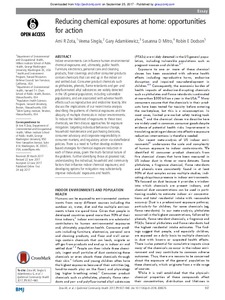Reducing chemical exposures at home: opportunities for action

Zota, Ami R. ; Singla, Veena ; Adamkiewicz, Gary ; Mitro, Susanna D. ; Dodson, Robin E.
Journal of Epidemiology and Community Health
2017
71
9
September
937-940
chemicals ; consumer goods ; detergent ; electronic equipment ; exposure ; nonoccupational factors
Chemicals
http://dx.doi.org/10.1136/jech-2016-208676
English
Bibliogr.
"Indoor environments can influence human environmental chemical exposures and, ultimately, public health. Furniture, electronics, personal care and cleaning products, floor coverings and other consumer products contain chemicals that can end up in the indoor air and settled dust. Consumer product chemicals such as phthalates, phenols, flame retardants and per- and polyfluorinated alkyl substances are widely detected in the US general population, including vulnerable populations, and are associated with adverse health effects such as reproductive and endocrine toxicity. We discuss the implications of our recent meta-analysis describing the patterns of chemical exposures and the ubiquity of multiple chemicals in indoor environments. To reduce the likelihood of exposures to these toxic chemicals, we then discuss approaches for exposure mitigation: targeting individual behaviour change, household maintenance and purchasing decisions, consumer advocacy and corporate responsibility in consumer markets, and regulatory action via state/federal policies. There is a need to further develop evidence-based strategies for chemical exposure reduction in each of these areas, given the multi-factorial nature of the problem. Further identifying those at greatest risk; understanding the individual, household and community factors that influence indoor chemical exposures; and developing options for mitigation may substantially improve individuals' exposures and health."
Digital
The ETUI is co-funded by the European Union. Views and opinions expressed are however those of the author(s) only and do not necessarily reflect those of the European Union or the ETUI.